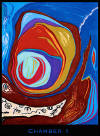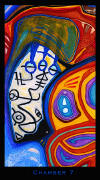|


by William Stevens
from
TheWingMakers
Website
INTRODUCTION
This memorandum will focus on two objectives:
1) Placing the artifacts
found at the Ancient Arrow site in the context of
current BST (Blank Slate Technology) initiatives
2) Describing the presumed
purpose of the various artifacts found within each of the 23
chambers
I think for purposes of this memorandum,
it would be better to begin with the description of the artifacts
and then follow-up with a description of how we -- of the scientific
core -- contemplate how the artifacts may be utilized in our current
BST initiatives.
CHAMBER PAINTINGS
Attached you will find high-resolution, fully cropped, photographic
copies of each of the 23 paintings discovered within the
Ancient Arrow site. As most of you know, these paintings
have not been fully decoded at this time. We've successfully decoded
about 65% of the glyphs and symbolic structure of the
paintings, but we believe that the glyphs represent only
one, albeit significant, element of the total story behind each of
the chambers.
The paintings have incredible detail and their coloration is
brilliant. Each of the chamber paintings has a similar color palette
and artistic style. We have done a painstaking analysis of both
contemporary and historical artists who have composed or painted in
a similar style, and we have found none. This style is truly
unique.
While none of our scientists within the Labyrinth Group
can claim to be an art critic, everyone who has seen the paintings
first-hand have been utterly amazed at their color and detail. If
you look closely at any particular area of the painting you will see
details emerge that draw the eye further into the painting. I think
one of the best ways to describe them is that they have a hypnotic
effect on the viewer, even when viewed through photographs, but
particularly when seen in person within the chambers themselves.
About a third of the glyphs contained on the paintings
can be traced to four different, extinct languages:
-
Chakobsan
-
Anasazi
-
Sumerian
-
Mayan
  However, the remaining
glyphs have absolutely no corollary to any other pictographic
language that we are aware of. Also, the glyphs found at the AA site
were completely different than those found within the chamber
paintings. It is interesting to note that the technology
artifacts within chambers 2 and 5 contained glyphs
represented in paintings found in chambers 1
(click image left) and 7
(click image right). However, the remaining
glyphs have absolutely no corollary to any other pictographic
language that we are aware of. Also, the glyphs found at the AA site
were completely different than those found within the chamber
paintings. It is interesting to note that the technology
artifacts within chambers 2 and 5 contained glyphs
represented in paintings found in chambers 1
(click image left) and 7
(click image right).
There are also representative glyphs that are of a universal nature
i.e., the spiral and concentric circles. These glyphs, while they
seem similar to those found on various rock structures in Utah,
Colorado, and New Mexico, they are more subtle in their line and
many have an incredibly detailed set of lines surrounding them that
seem to be part of the glyph as well. These lines have not been
decoded, though Dr. Owens is convinced they are an integral part of
their language.
{Please note the attached samples with their closest corollaries in
the Barrier Canyon and Classic Freemont styles.}
We are certain that the paintings were completed using unspecified
paints and an application technique requiring special tools.
Chemical analyses of the paints show conclusively that hybrid
compounds of selenium, gypsum, and jemsonite were used in all of the
paintings. The same polymer coating that was applied throughout the
interior of the AA site was also applied over the paintings. This
was done in a single layer, and has cohesion about 100 times greater
than our best derivatives formulated at our Donner Lab.
The paintings were produced with an unusual, if not haunting,
precision. They are perfectly rectangular, with sharp edges that
seem meticulously prepared as if purposeful in its mathematical
precision. However, we've not found any recognizable pattern in
their geometric proportions or mathematical disclosures.
Many of the paintings include depictions of the stars. We initially
thought these were arbitrary representations, but Drs. Nolan and Richards have suggested otherwise. The consistent and telltale sign
of the constellation Taurus and of particular interest, the 7th, or
the lost cluster, of
Pleiades is represented. The significance of
this is yet to be determined, but Owens believes it may relate to
the WingMakers' place of origin and time of entry to earth.
TECHNOLOGY ARTIFACTS
As you know, the disappointing news is that the technology artifacts
seem impregnable to our probes. It is as if the WingMakers wanted us
to start our analysis on the paintings and their cultural artifacts,
and leave the technology alone. However, we continue to probe with
ever-increasing persistence. The Corteum are bringing a new
technology that may help, but it will be about another three months
before we will be able to experiment with it.
For now, let me explain our findings, as minimal as they are. Since
my last update, we have continued to make good progress in decoding
the optical disc, though it is a slow, methodical process. We
believe our accuracy rates are extremely high, though we have yet to
determine how the glyphs factor into the translations from the
paintings and the AA site itself.
In the construction of the technologies, the most common metal is a
form of synthetic beryllium, and the most common mineral is
quartz or a synthetic variant. This synthetic quartz is extremely
conductive and has properties that seem responsive to human touch
and thought. Spectral analysis of the quartz artifacts demonstrate
that it is an amplifier of thought waves, but we cannot program the
amplification. It is completely spurious and unpredictable.
Under extreme magnification, the quartz is impregnated with a form
of nano-technology that we've never seen before. This technology
appears to act as the digital nervous system for the artifact, while
the synthetic quartz acts as its power supply and amplification
system.
Human genetics have been implanted into all of the quartz artifacts,
however, we're uncertain to what extent this is part of the smart
system and how much of this is related to a personal recognition
system that activates or channels the energy of the artifact based
on genetic interleaving as we prescribed in our AdamSon Project.
-- Classified Material --
|

